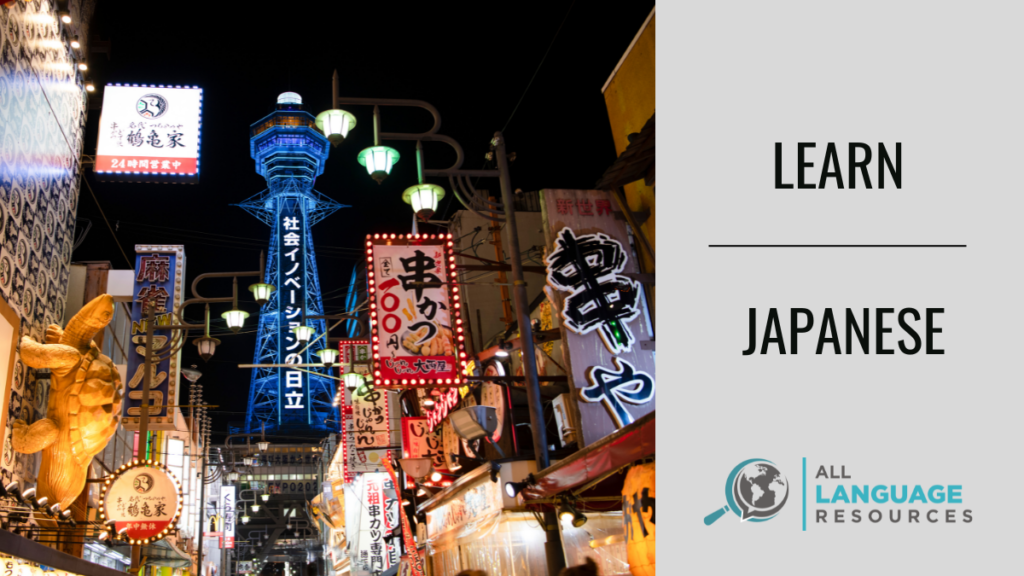Did you know that the Japanese language is considered a language isolate? This means that its relation to other languages cannot be easily proven.
Around 128 million people speak Japanese worldwide, with 99% speaking it as their native language. It is the official language of Japan and is also spoken by Japanese communities in different parts of the world.
Whether you want to tour Japan or you enjoy anime and manga, Japanese literature, art, history, and culture, knowing what resources work for you is key. Even if you find the Japanese language simply fascinating, it is important to identify your language learning preference and style in order to set a solid foundation for you to learn.
If you already know how you want to study Japanese and want to go straight to reading our reviews and recommendations for various Japanese resources, you may want to check these posts out:






From the Japanese writing system to Japanese grammar, speech, and vocabulary, understanding the very structure of the language is crucial to reaching fluency.
Learn Japanese for free with these tips and resources. How to learn Japanese fast? on my own? the easiest way? Find out all of that here. We’ll share what resources to look into and share some learning tips that’ll help you prepare accordingly. Keep reading!
Table of Contents
How to Learn Japanese on My Own
Make the most of the Japanese Sentence Builders books. The Japanese Sentence Builder series offers a comprehensive method of learning vocabulary in context, which helps with retaining vocabulary, as well as step-by-step walkthroughs for writing hiragana, katakana, and kanji. The authors regularly produce free additional content which is made available via their Twitter accounts to supplement the books.
How Long Does it Take to Learn Japanese?
The time it takes to learn Japanese varies greatly depending on factors such as your language learning experience, study habits, the intensity of study, and your proficiency goals.
However, the US Department of State suggests that it takes 2200 hours of learning to become fluent in Japanese. At thirty minutes per day, it will take twelve years to gain fluency. That might seem like a long time, but with shows and podcasts and games and books, it’s very easy to do more than thirty minutes per day, which will bring that number down dramatically.
1. Basic Conversational Level (JLPT N5): Achieving basic conversational proficiency, roughly equivalent to the JLPT (Japanese Language Proficiency Test) N5 level, may take around 300-400 hours of study. This level typically allows for simple conversations about everyday topics and basic reading and writing skills.
2. Intermediate Level (JLPT N4/N3): Progressing to an intermediate level, corresponding to JLPT N4 or N3, may require approximately 600-800 hours of study. At this level, you can engage in more complex conversations, comprehend basic written materials, and understand more advanced grammar and vocabulary.
3. Advanced Level (JLPT N2/N1): Achieving advanced proficiency, equivalent to JLPT N2 or N1, typically takes 1,000 hours or more of study. At this level, you can understand complex texts, express yourself fluently in various situations, and comprehend subtle nuances of the language.
How to Learn Japanese Fast
Learning any language takes time and dedication, and Japanese is no exception. However, Japanese isn’t as complicated as people think, and with the right approach and resources, it is possible to learn Japanese quickly and effectively. In this article, we will give you some hints and tips on how to learn Japanese fast, so you can impress your friends and navigate your way around Japan with no problems.
Immerse Yourself in Japanese
The fastest way to learn Japanese is to immerse yourself in the language.
Immersion refers to the practice of being surrounded by and using a foreign language in a natural setting. Most people think of immersion as traveling to the country where the language is spoken, but few of us have the resources to drop everything and move to Japan (as much as we might want to!)
Luckily, with the internet, it is no longer necessary to move countries to find a rich and authentic language learning environment. Simulated immersion experiences, online courses, or products that expose learners to the language in a variety of contexts and allow you to practice using the language in real-life situations, are readily available and very cost-effective.
But Why is Immersion Good for Learning Japanese Fast?
- Increased exposure to the language: Being immersed in a foreign language environment means that learners are exposed to the language on a regular basis, which helps you to become more familiar with its sounds, rhythms, and patterns. This increased exposure helps learners develop a better ear for the language, which is important for improving pronunciation and comprehension skills.
- Opportunities for authentic language use: Immersion provides learners with numerous opportunities to practice using the language in real-life situations. This allows you to learn how to use the language appropriately in different contexts and to gain a better understanding of its cultural and social norms.
- Natural language acquisition process: Immersion allows learners to learn a language in a way that is similar to how children learn their native language, by being surrounded by it and gradually picking up on its nuances and complexities. This natural process of language acquisition can be more effective than more traditional methods of language instruction that rely on drills and exercises.
- Improved motivation and engagement: Immersion can be a fun and exciting way to learn a language, as it allows learners to experience a new culture and interact with native speakers. This can lead to increased motivation and engagement in the language learning process.
Learn Japanese Pronunciation
Mastering pronunciation is an important part of Japanese learning. There is no sound similar to the English ‘r’ for example, and it’s important to make sure you learn the correct way to sound the letter ‘r’ in order to be understood.
It is also true that correct pronunciation will help you to understand as well as to be understood. The difference between ‘mikka’ (the third of the month) and ‘muika’ (the sixth of the month) can be quite subtle, and knowing the correct pronunciation will make sure you don’t miss your plans!
Correct pronunciation is a physical skill that can be practiced and perfected. It’s a case of being aware of where in your mouth to place your tongue and how to shape your lips.
If you’re serious about learning to speak Japanese and you want a method that makes good use of pronunciation teaching, check out some of our recommendations here with programs that focus on speaking.
Listen to Japanese Podcasts
Podcasts are a great way to improve your listening comprehension skills and pick up new vocabulary. Your existing skill level in Japanese will determine what kind of podcast you want to listen to. As your Japanese improves and you want to cross the boundary from upper-intermediate (B2) to Advanced (C1) you should look out for podcasts aimed at native speakers, about your favorite topics.
As a beginner, you would be better off using podcasts specifically designed for language learning. A typical podcast consists of a short audio lesson, mixing Japanese and English, which jumps between a dialogue and then an explanation of grammar and vocabulary.
We have many podcast recommendations in our Best Podcasts to Learn Japanese post.
Watch Japanese Films and Television
Another way to immerse yourself in the Japanese language, while exposing yourself to Japanese culture, is through watching movies and TV shows in Japanese.
It might be that you already do this. Watching anime and reading manga is a great gateway to learning Japanese. But as you watch or read, it’s important to be mindful of what you’re taking in. You won’t learn vocabulary by passively absorbing it, but there are several ways you can actively use Japanese media in your language learning.
The first is to read through the synopsis of a movie or TV show before watching it, and then watch it without subtitles. This way, you will have a general idea of what’s going on in the story, but you’ll also have to work on your listening skills to catch the finer points of the plot.
Another way to easily learn Japanese while watching TV or movies is to take a short clip and watch it at least once without any subtitles. You can try to write down the words you recognize and know and try to make sense of the clip. (To start with, do this in romaji. But as you become more confident with hiragana, katakana, and kanji, you can practice your writing skills as well!)
After you’ve watched the clip without subtitles, you can watch it again with Japanese subtitles, making note of the words you know and the ones you don’t. Finally, if you’re still stuck, you can turn on English subtitles the last time around.
Contemporary media is great for learning new words, especially slang, idioms, and colloquial expressions. But do be careful, because the overly dramatic nature of many anime series can give vocabulary that is not particularly useful or relevant to everyday life.
Set Clear Goals and a Realistic Timetable
One of the easiest ways to quit language learning is to be unrealistic about what you can achieve in a given time frame. The US Department of State suggests that it takes 2200 hours of learning to become fluent in Japanese, so don’t be disheartened if you feel like you’re not learning Japanese fast. It’s important to have a clear idea of what you want to achieve and how much time you’re willing to commit to studying. This will help you stay motivated and focused on your goals.
Find a Good Japanese Textbook or Online Course
There are many excellent textbooks and online courses available for learning Japanese. Look for ones that are tailored to your learning style and goals. Some popular options include “Japanese Sentence Builders” “Genki,” “Minna no Nihongo,” and “Japanese for Busy People.”
And most importantly, consistent practice is key to learning any language. Make a schedule for yourself and stick to it. Even just 30 minutes of practice per day will add up to those 2200 hours you’re striving for.
Focus on the Most Common Japanese Words and Grammar Structures
Japanese only has 100 distinct sounds (5 single vowels, 62 consonants combined with a vowel, and 53 consonants combined with ‘y’ and a vowel) so it’s not as difficult to pronounce as some other languages. However, with three native alphabets plus romaji, it does have a complex writing system and a unique grammar structure. Focus on learning the most common words and grammar structures first, as these will give you the most bang for your buck.
Use Mnemonic Devices to Help Remember New Japanese Words and Phrases
Mnemonic devices are techniques that help you remember new information by associating it with something you already know. For example, you might create a mental image of a man in kabuto armor holding a sword to help you remember the word for “samurai” (侍).
Take Advantage of Resources like Flashcards, Language Exchange, and Japanese Tutors
Flashcards are a great way to review new vocabulary, and there are many apps and websites that allow you to create and share flashcards with others. Language exchange websites allow you to find native Japanese speakers to practice speaking with, and usually there are many native Japanese who want to practice speaking English!
Also, don’t ignore 1-on-1 tutoring programs. They can provide personalized feedback and help you progress more quickly. Sometimes the language exchange scenes become messy resembling dating app scenes, and that can be a lifesaver. 🙂
Don’t Be Afraid to Make Mistakes
Making mistakes is an important part of the learning process. Don’t worry about being perfect – just try your best and keep learning from your mistakes. Especially what we have noticed about Japanese people is that they are SO APPRECIATIVE of your wanting to speak Japanese. Making mistakes may be a great way to get to know them, too!
Have Fun
Learning a new language can be challenging, but it should also be enjoyable. Find ways to make it fun for yourself, whether that’s through watching Japanese cartoons, listening to music, or trying out new Japanese recipes.
How Can I Learn Japanese Fast by Myself?
The tips in this article are great ways to learn Japanese as an independent learner. Other methods you might use if you don’t want to join a class or find a teacher include:
- Switch the language settings on your phone, computer, tablet, etc to Japanese. This will give you constant practice in recognizing the alphabet and picking up new vocabulary. Be careful, though, because it can be very difficult to navigate back to your first language settings if you’re not at a stage of reading Japanese fluently.
- Start watching Japanese shows, movies, anime, documentaries, etc. Many streaming services offer Japanese shows as part of their line-ups, and many (such as Crunchyroll) focus on streaming Japanese media exclusively.
- Listen to Japanese podcasts, music, and radio stations. Music is a great way to pick up new vocabulary and stay on top of what is fashionable in Japan.
- Find Japanese speakers where you live — it’s easier than you think! Japanese is a very fashionable language to learn, and lots of towns and cities have speakers of all levels.
What is the Fastest Way to Learn Japanese Fluently?
Don’t be afraid of writing. Many learners, when having to use a new alphabet, are afraid of writing things down and instead rely on Romaji. Learn the correct stroke order for the letters (using Japanese YouTube video demonstrations so you can see how the experts do it) and use a mix of Japanese symbols and romaji from the beginning. That way, you will quickly associate sounds and symbols, allowing you to read and write fluently in a much shorter time.
Can I Learn Japanese in 10 Days?
While you won’t become fluent in Japanese in 10 days, you certainly can learn a lot in a short amount of time. If you’re aiming for a short period of learning (perhaps because you’re getting ready to go on holiday) you should focus on what you absolutely need to know. Tourists, for example, don’t need the most complex grammar and should focus on asking for directions and reading signs. If you’re meeting your Japanese girlfriend’s parents for the first time, you should focus on polite forms of greetings, chit-chat phrases, and the appropriate way to show respect to people (which is very important in Japanese culture).
Easiest Way to Learn Japanese
The easiest way to learn Japanese depends on individual preferences and learning styles, but several strategies can make the process smoother. Starting with the basics of Japanese pronunciation and the Hiragana and Katakana scripts lays a strong foundation. Utilizing interactive resources like language learning apps can provide engaging practice opportunities. Immersing oneself in Japanese media, such as anime, manga, or J-dramas, exposes learners to natural language use and cultural nuances.
Additionally, finding a language partner or joining language exchange groups for regular practice can enhance speaking and listening skills. Keeping a consistent study schedule and setting achievable goals are key to maintaining motivation and making steady progress in learning Japanese.
How to Speak Japanese
Speaking Japanese involves several key steps, from learning basic vocabulary and grammar to practicing pronunciation and engaging in conversations.
1. Learn Hiragana and Katakana: Start by mastering the two Japanese syllabaries, Hiragana and Katakana, which represent basic sounds in the language. Understanding these scripts is crucial for reading and writing Japanese words.
2. Build Vocabulary: Begin expanding your vocabulary by learning common Japanese words and phrases. Start with essential words for everyday objects, greetings, numbers, and expressions. Language learning apps, textbooks, and online resources can be helpful for vocabulary acquisition.
3. Study Grammar: Familiarize yourself with Japanese grammar rules and sentence structures. Learn how to form basic sentences, ask questions, and use essential grammar patterns such as verb conjugation, particles, and honorifics.
4. Practice Pronunciation: Pay attention to Japanese pronunciation and practice speaking aloud to improve your accent and intonation. Focus on mastering the sounds of individual Hiragana and Katakana characters, as well as the pronunciation of words and phrases.
5. Immerse Yourself: Immerse yourself in the Japanese language and culture by watching Japanese movies, anime, TV shows, listening to Japanese music, and reading Japanese books or news articles. Exposure to authentic language use helps improve comprehension and fluency.
6. Stay Persistent and Patient: Speaking a new language takes time and practice, so be patient with yourself and stay persistent in your efforts. Celebrate your progress along the way and continue practicing regularly to achieve fluency in Japanese.
How to Learn Japanese for Free
There are numerous excellent resources available for learning Japanese for free, catering to learners of all levels. Websites like Tae Kim’s Guide to Learning Japanese and NHK’s Easy Japanese provide comprehensive lessons covering grammar, vocabulary, and cultural insights. For interactive learning, platforms like Duolingo offer gamified lessons that make studying Japanese engaging and fun.
Additionally, YouTube channels such as JapanesePod101 and Learn Japanese with JapanesePod101.com offer a wealth of video lessons, language tutorials, and listening practice exercises. Anki, a spaced repetition flashcard app, is also popular among Japanese learners for memorizing vocabulary and kanji.
Finally, language exchange websites like HelloTalk and Tandem connect learners with native Japanese speakers for language practice and cultural exchange. With these resources at your disposal, learning Japanese has never been more accessible or enjoyable.
By following these simple hints and tips, you will be speaking Japanese in no time at all!
頑張ってくださいね!
Ganbatte kudasai ne.
Good luck!

